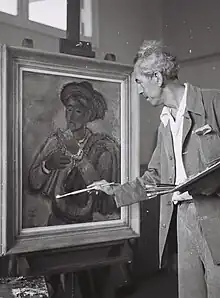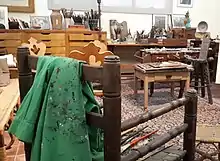Reuven Rubin
Reuven Rubin (Hebrew: ראובן רובין; November 13, 1893 – October 13, 1974) was a Romanian-born Israeli painter and Israel's first ambassador to Romania.[1]
Reuven Rubin | |
|---|---|
| ראובן רובין | |
 Reuven Rubin in his studio, 1946 | |
| Born | Rubin Zelicovici November 13, 1893 Galaţi, Romania |
| Died | October 13, 1974 (aged 80) Tel Aviv, Israel |
| Alma mater | Bezalel Academy of Art and Design in Jerusalem; the École Nationale Supérieure des Beaux-Arts in Paris |
| Style | Eretz-Yisrael |
| Spouse | Esther |
| Awards |
|
Biography
Rubin Zelicovici (later Reuven Rubin)[2] was born in Galaţi to a poor Romanian Jewish Hasidic family. He was the eighth of 13 children.[1] In 1912, he left for Ottoman-ruled Palestine to study art at Bezalel Academy of Art and Design in Jerusalem. Finding himself at odds with the artistic views of the Academy's teachers, he left for Paris, France,[3] in 1913 to pursue his studies at the École Nationale Supérieure des Beaux-Arts. At the outbreak of World War I, he returned to Romania to the city of Falticeni, where he spent the war years.
In 1921, he traveled to the United States with his friend and fellow artist, Arthur Kolnik, with whom he had shared a studio in Cernăuţi. In New York City, the two met artist Alfred Stieglitz, who was instrumental in organizing their first American show at the Anderson Gallery.[4] Following the exhibition, in 1922, they both returned to Europe. In 1923, Rubin emigrated to Mandate Palestine.
Rubin met his wife, Esther, in 1928, aboard a passenger ship to Palestine on his return from a show in New York City. She was a Bronx girl who had won a trip to Palestine in a Young Judea competition.[1]
Artistic career

The history of Israeli art began at a very specific moment in the history of international art, at a time of Cezannian rebellion against the conventions of the past, a time typified by rapid stylistic changes.[5] Thus Jewish national art had no fixed history, no canon to obey. Rubin began his career at a fortunate time.
The painters who depicted the country’s landscapes in the 1920s rebelled against Bezalel. They sought current styles in Europe that would help portray their own country’s landscape, in keeping with the spirit of the time. Rubin’s Cezannesque landscapes from the 1920s[6] were defined by both a modern and a naive style, portraying the landscape and inhabitants of Israel in a sensitive fashion. His landscape paintings in particular paid special detail to a spiritual, translucent light.
In Palestine, he became one of the founders of the new Eretz-Yisrael style. Recurring themes in his work were the biblical landscape, folklore and people, including Yemenite, Hasidic Jews and Arabs. Many of his paintings are sun-bathed depictions of Jerusalem and the Galilee. Rubin might have been influenced by the work of Henri Rousseau whose style combined with Eastern nuances, as well as with the neo-Byzantine art to which Rubin had been exposed in his native Romania. In accordance with his integrative style, he signed his works with his first name in Hebrew and his surname in Roman letters.
In 1924, he was the first artist to hold a solo exhibition at the Tower of David, in Jerusalem (later exhibited in Tel Aviv at Gymnasia Herzliya). That year he was elected chairman of the Association of Painters and Sculptors of Palestine. From the 1930s onwards, Rubin designed backdrops for Habima Theater, the Ohel Theater and other theaters.
His autobiography, published in 1969, is titled My Life - My Art. He died in Tel Aviv in October 1974, after having bequeathed his home on 14 Bialik Street and a core collection of his paintings to the city of Tel Aviv. The Rubin Museum opened in 1983. The director and curator of the museum is his daughter-in-law, Carmela Rubin.[1] Rubin's paintings are now increasingly sought after. At a Sotheby's auction in New York City in 2007, his work accounted for six of the ten top lots.[1]
Diplomatic career
In 1948, he became the first official Israeli diplomatic envoy (minister) to Romania. He served in this position until 1950.
Gallery
 The Beginnings of Tel-Aviv, oil painting, 1912
The Beginnings of Tel-Aviv, oil painting, 1912 Galilean Hills, oil on canvas
Galilean Hills, oil on canvas
Education
- 1912 Bezalel Academy of Arts and Design, Jerusalem
- 1913-14 École des Beaux Arts, Paris and Académie Colarossi, Paris
Awards and commemoration
- 1926 Awarded the Lord Plumer Prize
- 1945 Receives Honorary Doctorate of Hebrew Letters, Jewish Institute of Religion, New York
- 1964, Rubin received an "honorary award" of the Dizengoff Prize for Painting.[7]
- 1971 Awarded the "Artist of the year", University of Judaism, Los Angeles
- 1973, he was awarded the Israel Prize, for painting.[8]

See also
- List of Israel Prize recipients
- Highest price for Rubin's work ever in Israel "Shaykh-Munis" sold for 529,000$ at Tiroche auction house, 2011
References
- Rosenfeld, Jeannie (2008-04-14). "Demand for Reuven Rubin is rising. So are the prices". Haaretz. Retrieved 2008-05-31.
- "Falticeni". www.jewishvirtuallibrary.org.
- "Fine Art Auctions. Buying & Selling Israeli And Judaica Art – Hammersite.com". www.hammersite.com.
- "Reuven Rubin biography at Lucien Krief art gallery Jerusalem". Archived from the original on 2012-02-18. Retrieved 2011-12-30.
- Avishay Ayal, Land, Landscape, Gaze, Painting
- Webberley, Helen “Landscape Painting in Palestine: Not Just Cezanne with Olive Trees”, 20th Annual Conference, ACJC, Monash University, Feb 2008
- "List of Dizengoff Prize laureates" (PDF) (in Hebrew). Tel Aviv Municipality. Archived from the original (PDF) on 2007-12-17.
- "Israel Prize Official Site - Recipients in 1973 (in Hebrew)".
Bibliography
- Dalia Manor, "The Dancing Jew and Other Characters: Art in the Jewish Settlement of Palestine during the 1920s", Journal of Modern Jewish Studies, 1(1), 2002, pp. 73–89.
- Dalia Manor, "Imagined Homeland: Landscape Painting in Palestine in the 1920s", Nations and Nationalism, 9 (4), 2003, pp. 533–554.
- Dalia Manor, 'Art in Zion: The Genesis of Modern National Art in Jewish Palestine, London & New York, Routledge, 2005, esp. chapters 6, 7.
- Claus Stephani: Das Bild des Juden in der modernen Malerei. Eine Einführung. / Imaginea evreului în pictura modernă. Studiu introductiv. (Zweisprachige Ausgabe, deutsch-rumänisch. Ediţie bilingvă, româno-germană.) Editura Hasefer: Bucharest, 2005. ISBN 973-630-091-9
External links
- Reuven Rubin collection at the Israel Museum.
- "Reuven Rubin". Information Center for Israeli Art. Israel Museum. Retrieved 21 February 2012.
- Art of Reuven Rubin at Europeana. Retrieved {{{accessdate}}}
- Rubin Museum
- Reuven Rubin Catalogue Raisonne Project
- Rubin at the Art Cyclopaedia
- Reuven Rubin's "Goldfish Vendor" by Carmela Rubin
- Reuven Rubin from the Jewish Virtual Library